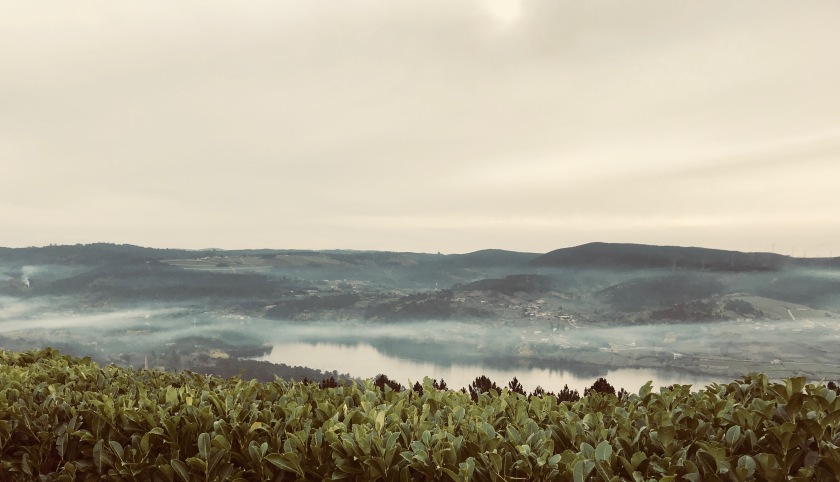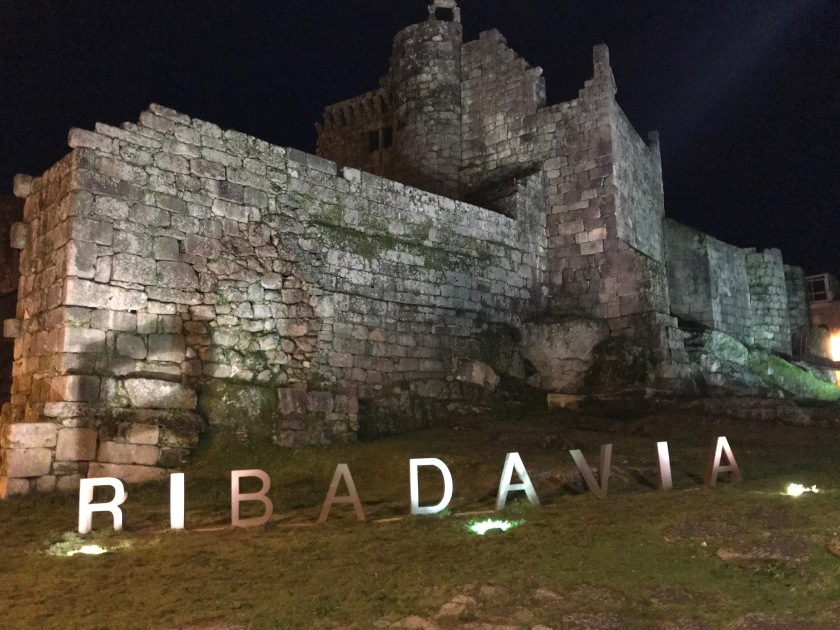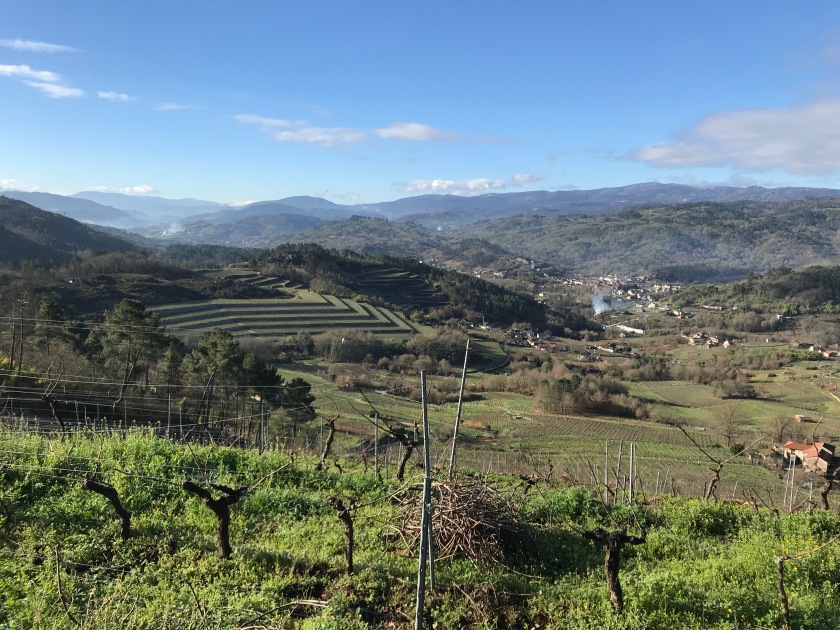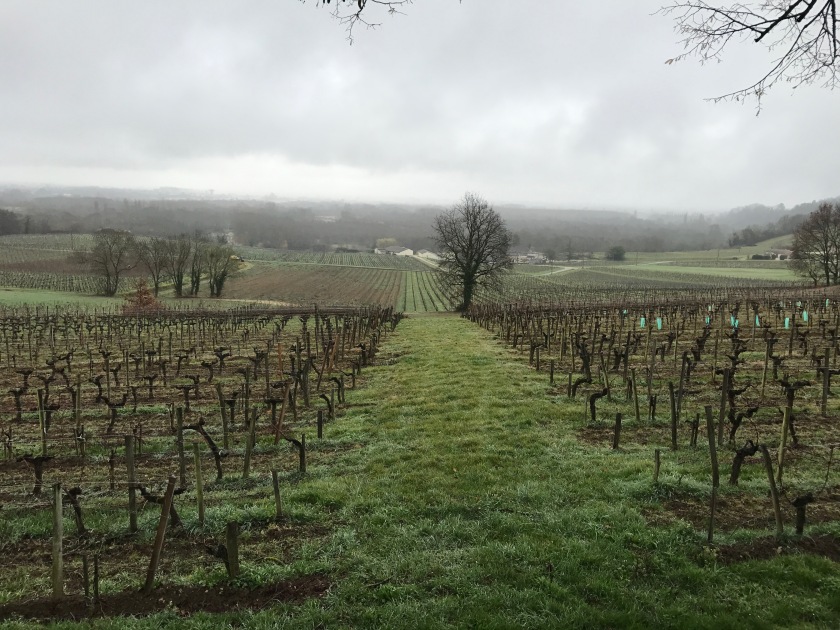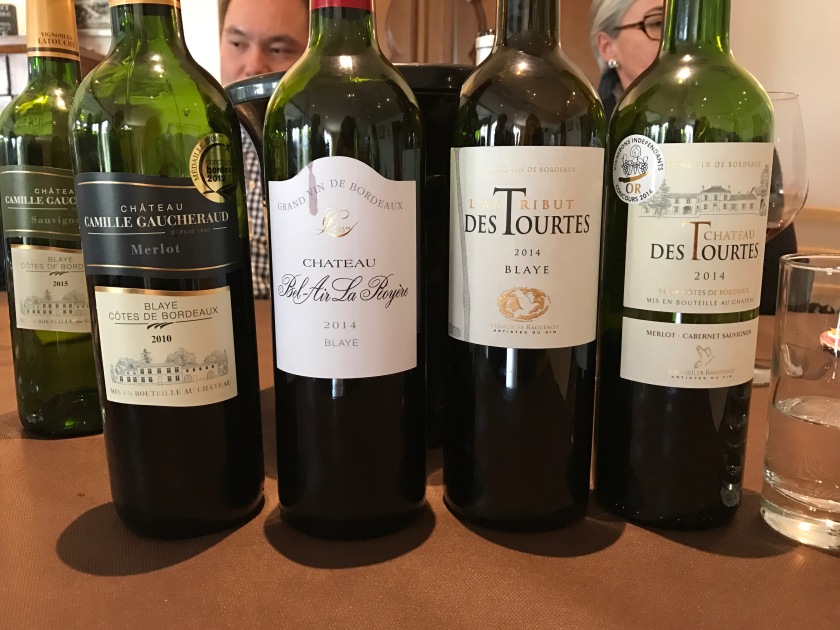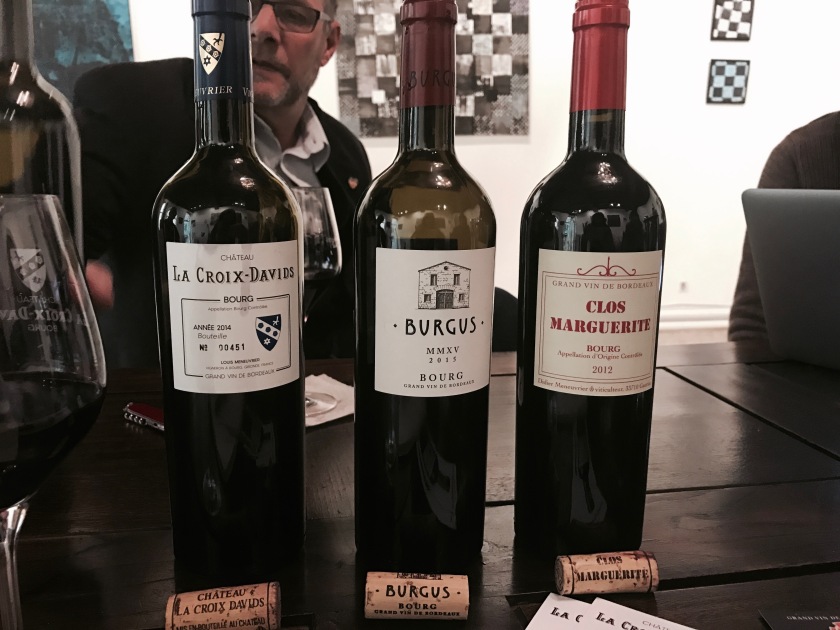(Almost forgot to post this one! And be sure to check out restaurants and wine bar recommendations at the end!)
Château Beychevelle Grand Cru Classé in St. Julien with Romain Ducolomb, Technical Director
Our final day back in the Medoc, we began at Beychevelle. As we stared out towards the Garonne from its back terrace, the technical director explained that it is important to be able to see the river– it indicates the best sites of the left bank, as it moderates the temperature and gives a light wind pattern to keep disease pressure lower.
We walked around the cellars and noted the higher toast regimen on his barrels– many indicated M+, where so many we had been to up to this point were M if not M-. We also learned that he uses only 50% new french oak during elevage. The higher toast and more moderate use of new oak compared to some other classified cru Bordeaux allows for the balance they are looking to achieve for the integration of flavors and aromas in their wine.
While we tasted through several vintages of Château Beychevelle, including ‘12, ‘06 and ‘01 (so elegant and pleasurable–needs to be consumed now), he asked us many questions about the American market. Like many others from this trip, he wanted to know how Parker scores were received now, if social media was effective, what young people might like to see from Bordeaux and what they could do to better reach the market. Beychevelle has felt that while they are selling their product as well as ever, the American market has waned for them, though not every estate shared this sentiment. For some, like Angelus, America is a top priority and market for them. We discussed with him the importance of personal contact, opportunities to give dinners and seminars, the challenge in smaller American markets competing with the futures games, where a couple larger outfits, like K&L, for example, often had significantly better pricing than what we could give collectors in our local markets (often less than what we can get at cost). We spoke of the changing thoughts on critical reviews– how many people are beginning to rely on peer reviews and professional comments on social media to inform their purchasing behavior. By sending students such as myself and Andrey over to have a personal connection to this region already has paid off in the seminars booked upon my return, as I hope to share this experience with consumers, students and clients of mine who look to me to guide them through massive negociant offerings twice a year. Finally, there’s more well made, fabulous wine than ever before. To offer lesser priced gateway wines at their estates as well as support the promotion of petit Château x and Cru Bourgeois is brilliant for cultivating interest in higher level labels.
Château Anthonic Cru Bourgeois in Moulis with Jean Bernard
Just 4.5 k away from the river and a world away, we came upon a quaint, humble estate in Moulis (a personal favorite!). Here in the land of much more clay, Merlot is more prevalent. Stepping back into time, large concrete tanks from the middle part of the last century were still the fermenter of choice– of course, many in Bordeaux and throughout France are fashionably bringing these back now that they are becoming less satisfied with inox. All in moderation, this Anthonic makes incredibly supple reds that bring freshness and very floral qualities to the rim– they are so drinkable right now! Only 25% new oak, this is certainly a more modest use of wood than we have seen from most others on the left bank. We were tickled by this young man’s modest character and clear connection to the land. His experience has also landed him a job at Château Dutruch, one of the most well-respected estates in Moulis.
Château Pontet-Canet Grand Cru Classé in Pauillac with Jean-Michel Comme, Technical Director
Our visit with Jean-Michel Comme, technical director at Pontet-Canet in Pauillac was one of the most impressionable I have ever had. And while there is much I want to say about this visit, it was his discussion of the vine that captivated me. I admit, while vinification has a certain level of geek appeal for me, the soils and vines have my heart. Here was someone who wanted to talk about that. He explained things in a way that exposed his true intimate relationship with the vine as a living, breathing thing that must have respect–as much, if not more, than a human being.
Without skipping a beat, he wanted to discuss esca– a trunk disease that is fast devastating vines throughout France. No one had been talking about this in Bordeaux. In fact, another estate said it wasn’t an issue there. Having traveled to the Loire and Burgundy last year, I knew how widespread it was becoming, so when Jean-Michel brought it up, I was all ears. This is being compared to the phylloxera of our time– the impact is anticipated to have similar effect.
He immediately dismissed much that has been published and the funding that has been misused to not find solutions. In fact, he explained, this was a disease that was written about to some extent already about 100 years ago by a man named Poussart. He read these works and better understood the nature of esca– causes and development. But he also, importantly, better understood how to try to cure the vine once affected. He likens it to a rotting tooth. Much of the time, you remove the disease part and fill the cavity. In the same like, like a disease or cancer, with early on site detection and removal, you can cure a vine. So he now has ‘cureators’ in the vineyard who are trained to work intimately with the affected vines. They have salvaged 80% of their vines now. So long as it doesn’t get down to the last root, they have a chance. It takes about a half hour per vine, but it is worth the investment of new vines from scratch which take a good 12-20 years to produce quality fruit. Plus, it the old roots they want to preserve and protect in the long run, as they can always graft over them with new vines if the rootstocks remain healthy. They have adopted massale selection as well for their Merlot and Cabernet Sauvignon (not economical for Petit Verdot and Cabernet France). They are also looking to bring over clones of Cabernet Sauvignon from America to better diversify their vineyards in the effort to create healthy sap and vine balance in the prevention of esca. Controlling vigor and maintaining healthy sap is the most important part to him. Really anything that can weaken the vine (Excessive vigor, pesticides, lack of soil health, lack of clonal diversity), all of this makes a vine open to disease. There is absolutely no green harvesting (he was quite against that) and they keep all buds on, so as not to suppress the growth. Their goal is to help a vine along the way but not really do much to it themselves. In this way, he explained, the land and the vine is the terroir, not the human. Humans are here to serve the artist (terroir).
Their attention to detail and balance does not stop in the vineyard. They had a remarkable cellar, where each decision is carefully made. And while they are quick to adopt new practices like inox fermentation in the late 80s, they are quick to remove it if it is not working as they hoped. In the late 90s they went back to large oak vats. Then they introduced concrete in the early 2000s. Now, they no longer use inox. This has improved the quality of their alcoholic fermentations, they feel.
During elevage, they age 50% of the wine in 50% new French oak and the other 50% in 9 hL concrete egg amphorae. They tried to experiment with large oak vats for aging about 10 years ago but found the tannins did not evolve well and the wine felt tired. Regular concrete vats were too thick. They custom designed the amphorae, with some that were a mixture of concrete and limestone from the land and others with gravel from the land. Though he could not give this skeptical student a taste nor a lab assessment, he said with 110% certainly that this changed the style of the wine tremendously. Those that aged in the limestone amphorae became more powerful, structured and angular. Those in gravel had more finesse and length on the palate. In fact, he often found a great harmony when matching the vessels to the opposite soil of the grape residing within. So those on gravel were best in limestone amphorae, for example. Believe it or not, I was hooked by this man’s conviction.
This was the first biodynamic estate of the Grand Cru Classé . And while some might use this for a ‘point of differentiation’ for better marketing, one could tell immediately that was not the aim here. They live and breath Bio. They try to have all their workers from the area, with benefits and ample work opportunities. Those they hire align with their philosophies. For example, their carpenter has helped locate woods that are not exotic, as he was learning that those often are sourced from areas that see exploited worker conditions. They would rather pay more and know where materials are coming from as it has a great impact in the long run. They also very focused on energy conservation at the moment. They have 67 geothermal wells, which operate much of their winery. Water comes out of the soil at 15-16C. Therefore, as an example, they can bring the temperature down from a 30C vat to 8C. While they still need to account for 7C, this saves a lot of energy.
We only had a chance to try the 2015 which is still developing and not released for another year. It was vibrant and alive. It had a personality that was unlike most I had tried. It was very raw and honest. I have not been fortunate to try many in my life, but I know I will never think of these wines the same again.
Château Phelan Segur in St. Estephe with Fabrice Bacquey, Maitre de Chai
Just when I thought there was no way anything could be impressive after that last visit, I came upon Phelan Segur–a remarkably different winery of St. Estephe. Left out of the classification, they offer great value and history to a classical Bordeaux consumer. Just as Pontet-Canet planted 1mx1m, so did Phelan Segur. This was quite common in these parts, forcing competition among vines. He openly admitted that they were hardly organic, but their attention to sustainability was growing stronger. Economically, it is not feasible to convert overnight. And I appreciated his honesty. It is not something people will just discuss and admit anymore, regardless of how common it must be to have more conventional practices, especially in a place like Bordeaux where disease pressure is higher.
One way they are quite innovative in the vineyard is through the use of Normalized Difference Vegetation Index (NDVI) in order to better understand the vigor of the vine. Herein lies the maturation potential and it greatly affects their selection. To him, this is more effective than simply picking by parcel location or soils. It reads the light space around the vine and can assist a grower for various decision during the season (especially for prevention, green harvest, etc) and at harvest for the precise time of selection. If there is high vigor, this often correlates to shorter extractions in the cellar. If lower vigor, this will correlates to riper tannins and therefore longer extractions. NDVI also helps inform how much fertilizer to apply– lower vigor requires more fertilizer up front. But also, in the long run, he explained, lower vigor also implies less leaves, which ensures the product application will be more effective and therefore require less application later and ultimately less chemicals overall.
Upon showing us the optical sorter, he noted that there is typically about 1% waste in a ‘normal vintage’ like 2016. For a vintage like 2013, it was 15%. I asked what they do with this waste, and it seems it’s quite valuable. For 9 hL, they typically receive anywhere from $3,000-$6,000 euro. So where they once made a rose of saignee to concentrate their reds and allow for another economic product of claret, now with more precise selection with NDVI and the optical sorter, they make more just selling what they don’t use in bulk.
After years and years of experimentation of various parcel blends, they realized the right combination for their house style and prefer to blend before it goes into the barrel for elevage and synthesis. It was interesting to learn about their Taransaud barrels. Most were either 333 or I.A., that I saw. He explained that 333 gave more powerful tannins, where I.A. was tighter grain that gave more elegance. Many were dried for 24-36 months, as is common, he noted. Some however, he really prefers 60 months of drying for even less oak character. He is also a stickler for texture in the resulting wine. So when he fines, he finds himself using gelatin more than the traditional egg whites. The former gives silkier finesse to the tannins, where egg white often create a bitterness he feels. They blind 7 magnums where three have one and three have the other of varying levels; one is a control. Nearly every time, the gelatin wins. He also finds it easier that he doesn’t need to report allergens to the consumer.
Day 6: Sauternes & Barsac
Clos Haut-Peyraguey 1er Grand Cru Classé with Clara Bouffard, Winery & Tourism Management
An appropriate way to end the trip, we traveled down to the foggy region of Sauternes for a couple visits. First was this famed classified 1er Cru Classé : Peyraguey. Here, we learned that Sauternes accounts for 2% of Bordeaux’s production, comprised of 170 producers. This estate is nearly 3 kilometers from the Ciron, the all important tributary that provides these grapes with the much needed botrytis-baby-making-machine. You can see right away how this all works. Just during the time we were there, from 10a until noon, we saw the settled fog rise to oblivion as it warmed. Here the clay subsoils are paramount, bringing freshness to the grapes. The gravel and sand on top helps drainage and overall quality for that matter. D’Yquem soils were remarkably white-toned in color compared to their neighbors. The uniqueness of this terroir is incredible. It is no wonder there is a lot of concern and worry from producers that a train might be built from Paris to Toulouse that would cross the Ciron not once but twice, disrupting the singular ecology of this sacred place.
They make two wines, as is common here. The Symphonie is a lighter style with only about 85-100 g/l of residual sugar and no new oak aging. It is treated like an aperitif. Their main label is more traditional at 125-140 g/l RS, seeing 20-22 months in French oak (30-40% new). These wines are classic and clean.
Château La Clotte-Cazalis with Marie-Pierre Lacoste-Duchesne, Winemaker
We couldn’t have concluded this trip on a better note. Meeting with Marie-Pierre was one of the highlights of this trip. She represented the 13th generation winemaker– one whom brought this sleepy estate back to life after 50 years of slumber since the last family member had the torch. Of course, they leased land in the meantime. And in fact, when they started again, they realized the value of their old equipment to remain as historical artifacts. I have rarely had the chance to see such old tanks, presses and cooperage tools. Especially in one room! To imagine how far vinification tools have come is a remarkable thing to comprehend. It is also no wonder the quality has skyrocketed.
This winery is steadfast into organic practices–they have been certified since 2015, although they have really been working towards it since she started in 2001. For her, it is a no brainer. The most important part of their job is to keep the fungus alive and healthy. Synthetic pesticides and herbicides will impact the biodiversity not to mention the health of the vines and the grapes. I asked how to control the mildew and prevent grey rot, but vigilance, prevention and visiting the vineyards daily is much more effective than anything else in her opinion. The cellar, to her, is merely there to maintain the potential achieved in the vineyard.
It takes 10 people to harvest and approximately 5-8 triages. In a near perfect year like 2016, it only took 3 times. Just as we saw in the Medoc and the right bank, 2016 gave great quality and quantity for those in Sauternes. Where Clotte-Cazalis typically gets around 12 hl/ha, 2016 saw 22 hl/ha! They use only Semillon in their first label, and they do not believe in using cryoextraction no matter how bad a vintage. Of grapes that are good enough to bottle, it is more interesting to them to see vintage variations. Consistency is not their main focus even if quality is– terroir and vintage character is most important. Her wines were gorgeous, a true testament to the quality that can be found in Barsac. We had both a 2005 and 2009–it was nice to experience such different vintages. For her, 2005 didn’t achieve the balance of 2009. Still, it was drinking nice right now– it wasn’t as opulent as the 2009, and it wore smoky, salty, savory notes… a more floral side of Sauternes. However, the 2009 was much more concentrated with florals, honeycomb and apricots in spectacular balance. The length was impressively persistent. I look forward to revisiting in 10 years…
Restaurants I can vouch for:
Brasserie Bordelaise
Potato Head
Le Bistrot des Quinconces
Le Bontemps (Near St. Julien in Cussac)
Restaurants with High recommendations we wanted to try:
Lion d’Or (Pauillac)
Le Miles
Garopapilles
Le Mampuku
Le Chien de Pavlov
La Cagette
Great Wine Bars:
Aux Quatre Coins du Vins
Vins Urbains
Le Point Rouge
L’Univerre
